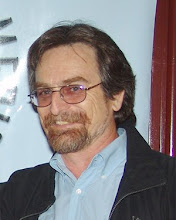What’s with all the sturm&drang about Roman Polanski? The guy committed a crime. He’s no different from any other criminal, as much of a genius as he might be. Now captured after 30 years, he is under house arrest in a Swiss mansion.
Wow, lucky Polanski!
If his skin were black or brown, he’d be lucky to not have been lynched. He’d be in an orange jumpsuit some prison in Central California with lots and lots of rough boyfriends with whom to discuss the finer points of camera lenses and working with actors, when they weren’t busy exploring his ‘inner realms’ (since they hate child molesters in the joint).
I think that he should stay under house arrest for a long long time. And if he wants to make movies, then he should use his creative mind to come up with ways to bring the set to himself, shooting only in his spacious Swiss mansion and the surrounding grounds. He could make a nice ‘drawing room’ drama, perhaps about the evils of lust and gluttony, or about the moral dangers of privilege and celebrity. Every film needs a theme, after all.
Or, Polanski could do what Coppola did in the early 80s. For One From the Heart, Coppola brought in a 'command center' built into a big Airstream trailer. And in that shiny silver bullet, Coppola could relax and eat his lunch while directing – without setting foot on the set) and he could make any movie he wants, anywhere in the world, from his luxurious Swiss mansion via satellite.
The 70s and early 80s were great times for experimenting with the process – especially for Coppola. He also developed a technique for shortening shooting time by extending rehearsal time and using that early period for rewrites and actual editing of his film. Taking a page from Alfred Hitchcock (who worked from a storyboard book with each shot so highly detailed that virtually anyone could have blocked and directed his films), Coppola used one assistant director to gaff his long rehearsal sessions on Cannery Row while tape-recording dialog and taking Polaroid snapshots. The actors would work in a big empty stage, with folding chairs and tables, as well as chalkmarks on the floor and walls to delineate rooms, doors and windows. The AD would record actors’ lines and take shots of them according to the script’s camera angles and lenses. When the actors went home, the AD would then videotape the snapshots while the cassette tape played, with all the scenes in order, and within a day or so Coppola would have a virtual edit of his film – using only one crew member. He would then review it and edit his script to reflect changes that would normally be made later in the editing process, after much footage would have been shot (at great cost in time and money). Then, the actors would be called back in to the same stage, in which actual furniture and painted backdrops would have been installed that modified script. In these sessions, the AD would be filming the action, per the updated script, with a video camera, capturing the shots called for: close-up, medium, wide, singles, two-shots, masters, etc. The actors would be released, and Coppola would then view the edited version of that script – and again re-edited the ‘sketch’ of the film. So before he had spent a dime on locations or crew (or actors’ fees, except for the very modest rehearsal fees) he would have the final clut of his film. It was estimated at the time that about a quarter of any budget could be trimmed away in this manner.
Mike Leigh works with his actors for like six months or more in character study and rehearsal (see the results in Happy Go Lucky), which is another thing that Polanski could do – with his actors visiting him in Switzerland.
Errol Morris conducts his documentary interviews from an adjoining room, via a video camera set behind a teleprompter on which his face is projected. The mediation of the director is a technique already in use, so why not use it to a good purpose?
So what’s my point? Well, Polanski is a highly creative guy – so let him figure out ways to do his time like a man, hold his mud, and stfu. He could stop sniveling, bring his actors to Switzerland, put them up in his big old mansion, and engage them in intensive work on their characters, using Coppola’s second technique to reduce set time. Then he could use Coppola’s first technique to get the film made, directing remotely.
So my message to Polanski: “Enough wyngeing already, Roman – use your (much deserved) restrictions to come up with a masterpiece!
David Hakim is an assistant director, producer, and publicity expert who developed campaigns for every major Hollywood studio and handled publicity for the Motion Picture Academy. Find him in the Reel Directory online: www.reeldirectory.com.
All material copyright 2010 David Hakim and may not be duplicated - ALL RIGHTS RESERVED.
domingo, 9 de mayo de 2010
Rosemary's Baby, 2010
Suscribirse a:
Comentarios de la entrada (Atom)





No hay comentarios.:
Publicar un comentario